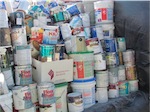It was a beautiful Sunday on May 5th for the ninth annual Bringing Back the Native Garden Tour organized by Kathy Kramer, a recent Jefferson Award winner for outstanding public and community service.
There were 43 native gardens on tour this year. Two key qualifications for the native garden tour are 1) the garden contains at least 50% of native plants, and 2) insecticide cannot be used in these gardens.
13 gardens contain 90% or more native plants. Native gardens need little or no water after they are established, which usually take one to two years. These homeowners must be very happy to see their low water bills. In general, landscape can account for over 40% of water usage in the summer months.
I visited two gardens in the morning. I really like one of the garden in Walnut Creek. The garden is 80% native. I was fascinated by their unobtrusive high fence in the front garden that keep deer away. They use branches from trees cut from their yard to create interesting decorations for the fence. Shrubs were planted to soften the presence of the fence.
In another garden in Orinda, you can also see how the native grass look like after it is mowed. If you don’t want to mow it, it grows up to 18 inches tall and bend over looking like a meadow. The native grass requires 50% less water compared to conventional grass such as Kentucky Blue or Rye.
There were native plants sales at some tour locations on the tour day. It was convenient for garden visitors to purchase native plants after seeing all those inspiring native gardens.
I volunteered to help show the plants in one garden in Orinda. This is a large property with a creek and uplands in the back garden. Once it was full of invasive plants. After the homeowner removed them and the natives are returning. He also designed and built two bridges that take you to the benches of the uplands. I can imagine that one can sit and meditate there and forget what is going on outside and beyond. The front garden used to be a large green lawn and was converted to a green meadow using Melica Toreyana. The garden now contains 95% native plants.
The overall tour was well organized as usual. The names of the plants were clearly labeled. Visitors could see how the plants look like and write down the plant names they like. They can get these plants for their own gardens. Some thoughtful homeowners distributed lists of plant names used in their gardens. Plant lists can also be downloaded from the Bringing Back the Native Garden website.The purpose of the Native Garden Tour is to educate the pubic that native plants can save our precious water and eliminate harmful pesticides in our gardens. It is sponsored by several public water companies and cities in Contra Costa County and Alameda County. Admission is free to the public and is being held annually on the first Sunday of May.
For the 2014 tour, check back on our Event Calendar (around January) or visit the Bringing Back the Native Garden website.








